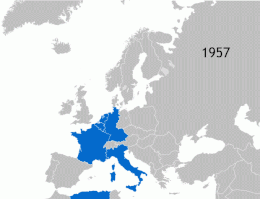
Back انسحاب جرينلاند من المجموعات الأوروبية Arabic Keluarnya Greenland dari Uni Eropa ID 欧州諸共同体からのグリーンランド脱退 Japanese Wetuné Tanah Ijo saka Komunitas Ékonomi Éropah JV Grönlands utträde ur Europeiska gemenskaperna Swedish Вихід Гренландії з Європейських Співтовариств Ukrainian 格陵兰退出欧洲各共同体 Chinese
| Treaty amending, with regard to Greenland, the Treaties establishing the European Communities | |
|---|---|
| Signed | 13 March 1984 |
| Location | Brussels |
| Effective | 1 February 1985 |
| Signatories | 10 |
| Depositary | Government of the Italian Republic |
| Languages | All 8 official Languages of the European Communities |
| Full text | |

After being a part of the European Communities (EC) for twelve years, Greenland withdrew in 1985. It had joined the EC in 1973 as a county of Denmark, even though a majority in Greenland was against joining. In a consultative referendum in 1982, 53% of the electorate of Greenland voted to withdraw from the Communities.[1] This latter referendum became possible after the introduction of home rule in Greenland in 1979. Following its withdrawal, which was regulated through the Greenland Treaty, the relationship between Greenland and the EC was partly settled through an association under Overseas Countries and territories (OCT) status.[2] In recent years, the Greenlandic withdrawal from the European Communities has marginally been referred to as "Greenxit".[3][4]
- ^ Cite error: The named reference
since1945was invoked but never defined (see the help page). - ^ "Glossary of summaries - Overseas Countries and Territories". EUR-Lex. Retrieved 1 March 2021.
- ^ Patel, Kiran Klaus (2018). "Something new under the sun?". In Martill, Benjamin; Staiger, Uta (eds.). Something new under the sun?: The lessons of Algeria and Greenland. Rethinking the Futures of Europe. UCL Press. pp. 114–120. doi:10.2307/j.ctt20krxf8.18. ISBN 978-1-78735-276-6. JSTOR j.ctt20krxf8.18. Retrieved 2021-10-20.
{{cite book}}:|work=ignored (help) - ^ Riddoch, Lesley (2017). McSmörgåsbord: What post-Brexit Scotland can learn from the Nordics. Luath Press Ltd. ISBN 978-1-910324-91-2.